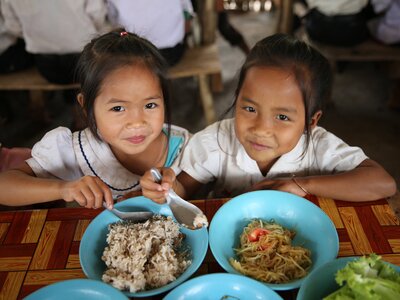Lao People's Democratic Republic
- 18%
- of people live on less than US$1.25 a day
- 33%
- of children under 5 are stunted
- 7.5 million
- population
A mountainous, landlocked country, the Lao People’s Democratic Republic (Lao PDR) is one of the most sparsely populated countries in Asia. Its predominantly rural, 7.5 million strong population lives in over 10,000 villages – most of which have but a few hundred inhabitants – in remote, ethnically diverse areas. Due to remoteness, people in these scattered communities face challenges to access essential services.
In recent years, Lao PDR ranked as one of the fastest growing economies in East Asia and the Pacific, but the benefits are not evenly spread across regions. Lao PDR has seen a decrease in poverty, but despite these improvements, nutrition and food insecurity remain a persistent problem, especially among low-income families in rural areas. Almost 20 percent of the population already experienced moderate to severe food insecurity before the COVID-19 pandemic, with a higher incidence in rural areas and the central region.
What the World Food Programme is doing in Lao PDR
-
School meals
-
WFP has been working in partnership with the Government of Lao PDR on promoting access to nutritious food for school-age children for two decades, especially in remote and ethnically diverse areas. The transition from implementing an integrated package of support in schools towards incorporating it into a government-led and community-driven food safety net, is ongoing through technical assistance, policy, and fundraising support, as well as strengthening the capacities of Government and communities.
-
Nutrition
-
To address all forms of malnutrition in line with national targets, WFP focuses on women and girls of reproductive age (between 15 and 49 years), school-age children and children under 5. WFP works to positively influence health and nutrition behaviours by providing a package of nutrition services and strengthening institutional capacities, to create an enabling environment for better nutrition. Together with its partners, WFP explores local production of fortified staple foods, promotes evidence generation on drivers of food choices, and advocates for emerging nutrition issues, such as overweight and obesity.
-
Resilience
-
Targeting vulnerable people in disaster-affected or at-risk areas, WFP works on building the resilience of communities to enhance food and nutrition security all year round. Communities are capacitated to mitigate and manage risks associated with climate-related disasters and other shocks. Additionally, WFP supports the development of institutional capacities at national and sub-national levels to manage climate and disaster risks.
-
Emergency response
-
WFP provides nutritious food and cash assistance to help meet the essential needs of crisis-affected people when needs exceed the Government’s capacity to respond. Vulnerable groups include people affected by disasters, seasonal food insecurity or loss of income and livelihoods due to health and economic shocks.
In focus
LAO PDR: ‘How I dreamed of wearing a WFP blue jacket when I was a boy’
Story | 1 November 2022
Healthy little seeds for strong little bodies
Keo’s story: Good nutrition can save lives
How helping in the wake of a disaster led to a career with WFP
The leaves of life
Story | 24 May 2019
“Happier, healthy people are my greatest reward”
Lao People's Democratic Republic news releases
Go to pagePartners and donors
Find out more about the state of food security in Lao People's Democratic Republic
Visit the food security analysis pageOperations in Lao People's Democratic Republic
Contacts
Office
Vientiane Country Office Don Nokhoum Road, Don Nokhoum Village, Sisattanak District, Vientiane Capital
Vientiane
Laos







